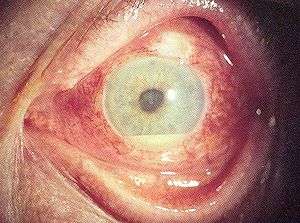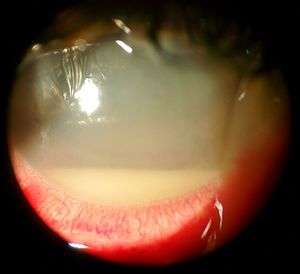Hypopyon
Hypopyon is a medical condition involving inflammatory cells in the anterior chamber of the eye.
| Hypopyon | |
|---|---|
 | |
| Hypopyon seen as yellowish exudate in lower part of anterior chamber of eye | |
| Specialty | Ophthalmology |
It is a leukocytic exudate, seen in the anterior chamber, usually accompanied by redness of the conjunctiva and the underlying episclera. It is a sign of inflammation of the anterior uvea and iris, i.e. iritis, which is a form of anterior uveitis. The exudate settles at the dependent aspect of the eye due to gravity. It can be sterile (in bacterial corneal ulcer) or not sterile (fungal corneal ulcer).
Differential diagnosis

Hypopyon can be present in a corneal ulcer. Behcet's disease, endophthalmitis, panuveitis/panophthalmitis and adverse reactions to some drugs (such as rifabutin).[1]
Hypopyon is also known as sterile pus, as it occurs due to the release of toxins and not by the actual invasion of pathogens. The toxins secreted by the pathogens mediate the outpouring of leukocytes that settle in the anterior chamber of the eye.
An inverse hypopyon is different from a standard hypopyon. Inverse hypopyon is seen after a pars plana vitrectomy with an insertion of silicone oil (as a replacement of the vitreous humour that has been removed in the operation; the silicone oil maintains internal tamponade). When the silicone oil emulsifies, it seeps into the anterior chamber and settles at the top of the anterior chamber. This is in contrast to hypopyon resulting from toxins where the leukocytes settle at the bottom of the anterior chamber. This is due to the effect of gravity, hence the name inverse hypopyon.
Treatment
A hypopyon should not be drained, because it offers protection against the invading pathogen due to the presence of white blood cells, although long-standing hypopyon can cause close-angle glaucoma[2] and anterior synechiae.[3]
Intravitreal antibiotics can be used if endophthalmitis is suspected.
References
- Huang, John H.; Gaudio, Paul A., eds. (2010). "Hypopyon". Ocular Inflammatory Disease and Uveitis: Diagnosis and Treatment. Lippincott Williams & Wilkins. p. 204.
- "Narrow-Angle Glaucoma". allaboutvision.com. Retrieved 16 November 2016.
- "Peripheral Anterior Synechia Treatment & Management: Medical Care, Surgical Care, Consultations". emedicine.medscape.com. 18 October 2016. Retrieved 16 November 2016.
- Gonzalez-Granado LI. Aspergillus endophthalmitis: Pars plana vitrectomy is an alternative Indian J Med Sci 2009;63(8):366-367. doi:10.4103/0019-5359.55892 most of the time without proper medical care patients end up with blindness.